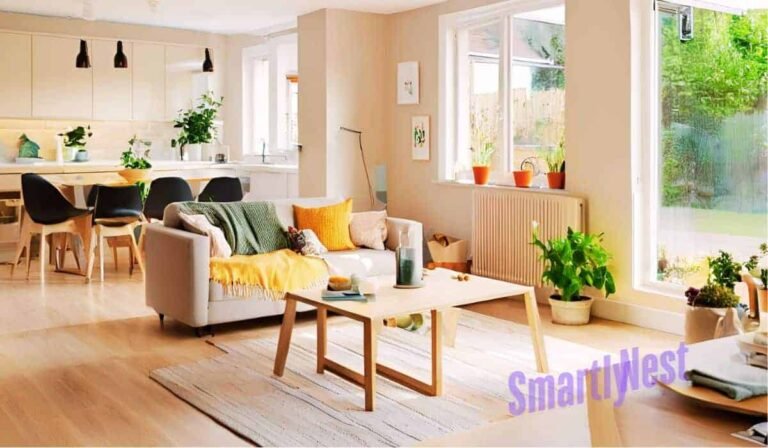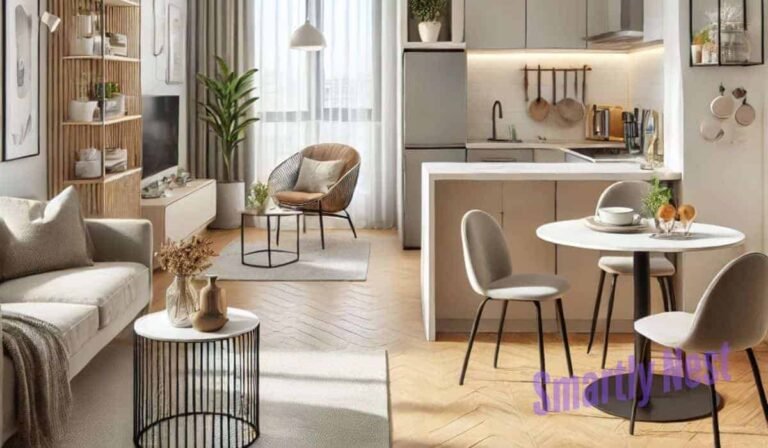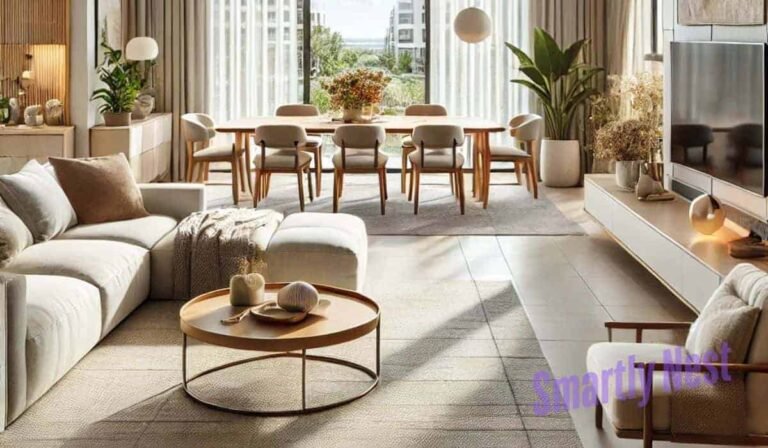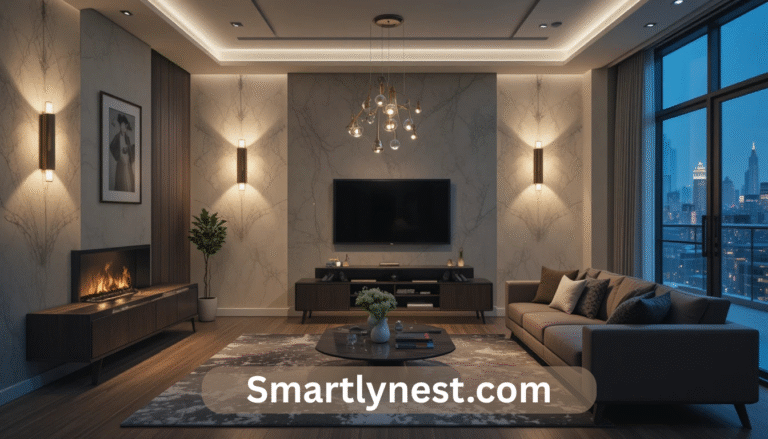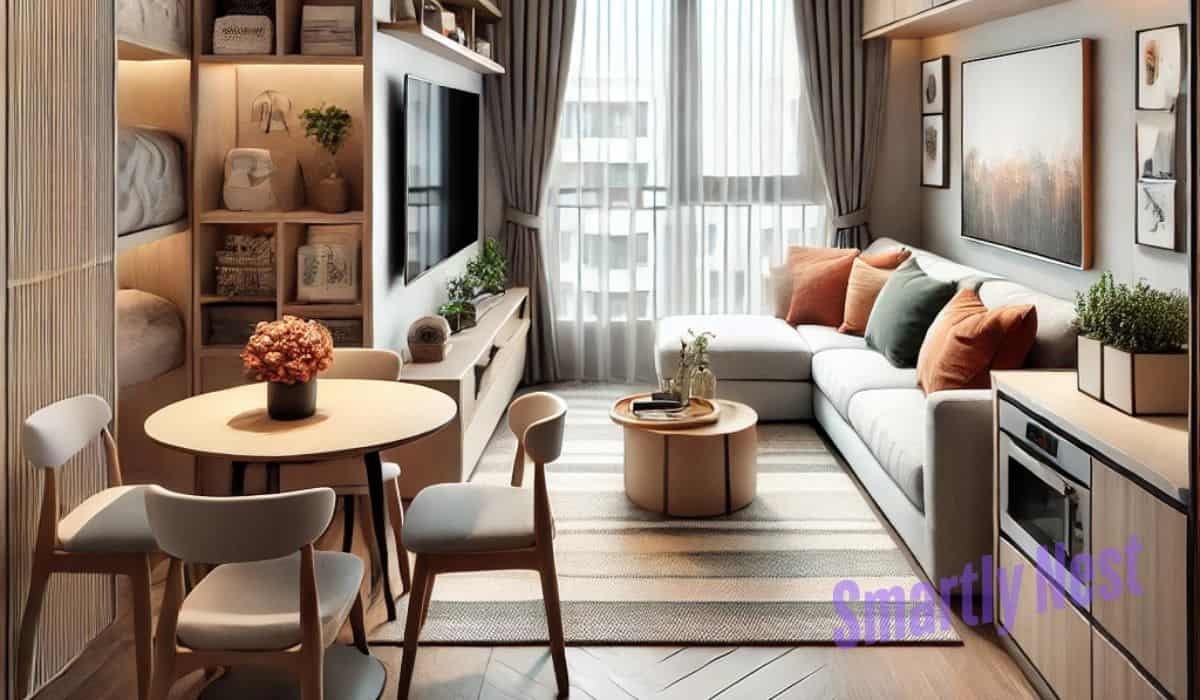
Designing a small living room that also serves as a dining space can feel like an overwhelming task. With the right approach, you can make it functional, stylish, and, most importantly, comfortable. Combining these two spaces often requires creative solutions, especially when you want to integrate a TV without overcrowding or compromising style. Here, we explore 17 layout ideas that can help you maximize your small space, making it both beautiful and highly functional.
1. Embrace Multi-Functional Furniture
1.1 Convertible Coffee Tables
In smaller spaces, every inch counts. One of the best ways to save space and increase functionality is by choosing furniture that serves more than one purpose. Convertible coffee tables are an excellent example. These tables can transform into dining tables or even extend to accommodate guests.
For example, a standard coffee table can be elevated and expanded to a dining table when you need it. This can be particularly useful in studio apartments or smaller homes where you need to maximize space without sacrificing usability.
Key Benefits:
- Space-saving solution
- Versatile and practical for day-to-day life
- Ideal for spaces that need a multi-use centerpiece
1.2 Storage-Integrated Seating
One of the biggest challenges in small living-dining rooms is storage. Integrated storage in seating solutions, like sofas with built-in drawers or benches with hidden compartments, is perfect for reducing clutter. These furniture pieces offer the dual benefits of providing seating and serving as storage space for items like blankets, magazines, or remote controls.
These storage solutions help you maintain a tidy environment while still having ample seating for guests or family members.
Key Benefits:
- Combines comfort with storage
- Saves floor space
- Helps keep the room organized
1.3 Extendable Dining Tables
An extendable dining table is one of the most useful pieces of furniture you can incorporate into a small living-dining combo. When not in use, it can be compact, but when you have guests, you can easily extend it to accommodate more people. These tables come in many styles, including circular, rectangular, and square shapes, so they can suit any interior design.
Key Benefits:
- Provides flexibility for hosting guests
- Space-efficient
- Great for homes with limited space
2. Optimize TV Placement
2.1 Wall-Mounted TVs
Mounting the TV on the wall is a simple and effective way to save floor space and make your living room feel larger. Wall-mounted TVs have become a standard in modern homes because they offer a sleek, minimalist look and free up space that can be used for other furniture or decor.
Moreover, mounting the TV at the correct height helps create a more comfortable viewing experience, especially when you’re using your living room for both lounging and dining.
Key Benefits:
- Frees up valuable floor space
- Modern, clean aesthetic
- Adjustable viewing angles with swivel mounts
2.2 Swivel TV Mounts
If your living and dining areas overlap in terms of the TV’s viewability, a swivel TV mount is a fantastic option. This allows the TV to pivot, providing flexibility in viewing angles. You can enjoy the TV from the dining table or the sofa, depending on where you’re sitting, without having to shift the furniture around.
Key Benefits:
- Adjustable viewing angles
- Ideal for shared spaces
- Great for accommodating multiple seating areas
2.3 Concealed TV Solutions
For a truly clean, uncluttered space, consider a concealed TV solution. There are many modern options available where the TV is hidden within cabinetry or mounted on a lift that can raise the TV at the push of a button. This works exceptionally well for multi-purpose rooms where you want the focus to shift between the dining area and the TV zone.
Key Benefits:
- Aesthetically pleasing and minimalist
- Keeps the focus on dining or other activities
- Ideal for multifunctional spaces
3. Define Zones with Rugs and Lighting
3.1 Area Rugs
Using rugs is an effective way to visually separate your living and dining areas. In small spaces, it can be difficult to create distinct zones, but a large rug in the living area and a smaller one beneath the dining table can help define each space. Rugs also add texture, warmth, and color to the room, enhancing its overall aesthetic.
Key Benefits:
- Creates visual boundaries between the living and dining areas
- Adds warmth and texture to the space
- Helps tie the room’s design together
3.2 Layered Lighting
Lighting is crucial in a small living-dining combo. A well-lit room can feel larger, more welcoming, and more functional. Consider using layered lighting to achieve the right atmosphere. Ambient lighting provides overall brightness, task lighting illuminates specific areas like the dining table, and accent lighting can highlight features like artwork or architectural details.
Use pendant lights or chandeliers over the dining table, floor lamps in the living area, and recessed lighting in the ceiling to keep the room well-lit and balanced.
Key Benefits:
- Adds depth and dimension to the room
- Makes the space feel larger and more inviting
- Enhances functionality by focusing light on key areas
4. Utilize Vertical Space
4.1 Floating Shelves
When you’re working with limited floor space, look to the walls for storage. Floating shelves are an excellent solution for displaying decorative items or storing everyday essentials like books, vases, or framed photos. These shelves can be installed above the TV, along the dining wall, or in the corners of the room to keep things organized without overcrowding the floor area.
Key Benefits:
- Maximizes vertical space
- Provides additional storage without taking up floor space
- Offers decorative opportunities for styling
4.2 Tall Storage Units
Tall storage units are another great way to use vertical space efficiently. By choosing tall, narrow cabinets or bookcases, you can store a large number of items without taking up too much of the room’s footprint. These units can house everything from dinnerware to books, ensuring that your living-dining combo stays organized and functional.
Key Benefits:
- Makes full use of vertical space
- Keeps floor space clear and open
- Provides ample storage for small spaces
5. Choose Appropriate Furniture
5.1 Slim-Profile Furniture
In small rooms, bulky furniture can quickly make the space feel cramped. To avoid this, opt for slim-profile furniture with clean lines and a minimalist design. For example, choose a narrow sofa or a slim dining table that won’t dominate the room but still provides comfort and utility.
Key Benefits:
- Keeps the space feeling open and airy
- Prevents the room from feeling cluttered
- Makes the room look modern and stylish
5.2 Modular Seating
Modular seating is ideal for small living areas. These sofas can be reconfigured in different ways, depending on the layout of your room or the number of people using the space. The flexibility of modular seating makes it perfect for multifunctional rooms where you need to maximize both seating and space.
Key Benefits:
- Customizable seating options
- Flexible design that adapts to your needs
- Perfect for both small and large gatherings
5.3 Round Dining Tables
In a small room, a round dining table can be a great option. Unlike square or rectangular tables, which can have sharp corners that take up more space, round tables allow for better flow and can seat more people while requiring less floor area. Additionally, they make it easier to move around the room.
Key Benefits:
- More space-efficient than rectangular tables
- No sharp corners, which is safer for tight spaces
- Allows for better seating arrangements and more people at the table
6. Incorporate Built-In Features
6.1 Built-In Banquettes
A built-in banquette or bench seating along the wall can serve as a cozy dining spot while saving valuable floor space. These can also double as storage units for linens, tableware, or other household items. Built-ins are especially useful in small spaces as they provide seating and storage without occupying the entire room.
Key Benefits:
- Saves space by using wall space for seating
- Can include storage for extra convenience
- Adds a cozy, intimate feel to the room
6.2 Integrated Lighting
Built-in lighting, such as under-cabinet lights or recessed ceiling lights, can be a subtle yet effective way to illuminate your space. Lighting that’s integrated into the furniture or structure enhances the room’s overall look and feels seamless with the design.
Key Benefits:
- Creates a sleek and minimalist aesthetic
- Reduces clutter and unnecessary fixtures
- Enhances the ambiance of the space
7. Maintain a Cohesive Color Scheme
In a small living-dining combo, it’s essential to maintain a consistent color scheme to make the space feel cohesive. Neutral tones work well in smaller spaces as they make the room feel open and inviting. However, don’t be afraid to use bold accent colors or patterns to add personality to the space.
7.1 Neutral Base with Accent Colors
Stick with neutral base colors for the walls and larger pieces of furniture, such as beige, light gray, or white. These tones provide a light and airy foundation that makes the room feel larger. Then, add pops of color through accessories like pillows, throws, tableware, or artwork. This combination allows for flexibility in your design without overwhelming the space.
7.2 Monochromatic Palettes
A monochromatic color scheme uses various shades of one color, creating a serene and unified look. This approach can make the space feel more expansive and is a great option for small rooms. Consider pairing lighter and darker shades of the same color to add depth and visual interest while keeping the space cohesive.
8. Implement Smart Storage Solutions
8.1 Hidden Storage
In small spaces, keeping things out of sight can make a huge difference. Hidden storage can be integrated into various pieces of furniture, from ottomans to coffee tables, to keep clutter at bay. Furniture pieces with secret compartments or built-in drawers are particularly useful for maintaining a clean and organized room.
8.2 Open Shelving
On the other hand, open shelving can add a stylish element to your design while providing easy access to everyday items. Display decorative items or store essentials like dishes or books, making them part of the room’s overall aesthetic.
9. Create a Focal Point
9.1 Statement Art Pieces
Adding artwork or large decorative pieces can make a room feel more complete and give it character. Whether it’s a large painting above the sofa or a striking sculpture next to the dining area, statement art can help define the space and make it feel special.
9.2 Feature Lighting
Pendant lights, chandeliers, or other statement lighting fixtures can act as a visual anchor for your dining area. Consider a stylish pendant light above your dining table to create a focal point while also improving the lighting.
10. Consider Layout and Flow
10.1 Open Floor Plan
Keeping the room’s layout open and flowing naturally helps the space feel less cramped. Avoid placing large furniture pieces in the middle of the room, which can impede movement.
10.2 Strategic Furniture Arrangement
Arrange your furniture strategically to ensure each area has clear pathways and enough space for both dining and relaxation. Avoid pushing all furniture against the walls as this can make the space feel less intimate.
11. Personalize with Decor
11.1 Decorative Accessories
Pillows, throws, rugs, and small accessories can add personality and warmth to the room. These items help make the space feel homier while not taking up too much space.
11.2 Indoor Plants
Plants bring life and freshness to any space. Adding greenery can help balance out more neutral elements and provide natural beauty, especially in small spaces where you need a touch of nature.
12. Maintain Flexibility
12.1 Multi-Use Spaces
In a small living-dining combo, versatility is key. You should design your space so that it can serve multiple purposes. For instance, your dining table can double as a workspace or even a crafts table when not being used for meals. Similarly, a comfortable armchair can serve as additional seating for the dining area or a cozy spot to relax while watching TV.
Key Benefits:
- Maximizes the use of every square inch
- Allows for easy reconfiguration based on needs
- Great for shared spaces where functionality is important
12.2 Mobile Furniture
Another great way to maintain flexibility is to incorporate furniture on wheels. Items like a mobile bar cart, rolling coffee tables, or even seating with wheels can be easily moved around as needed. This flexibility is especially useful in rooms where you want to change the layout depending on the occasion, such as hosting a dinner party or a movie night.
Key Benefits:
- Easy to rearrange for different events or purposes
- Reduces the need for a rigid room layout
- Provides adaptability for small spaces
13. Enhance Natural Light
13.1 Light Window Treatments
Natural light can do wonders in a small room, making it appear larger and brighter. To maximize light, choose light, airy window treatments that let sunlight flood the room. Sheer curtains, lightweight blinds, or even no window treatments at all (if privacy allows) can provide the natural light you need without feeling heavy.
Key Benefits:
- Makes the room feel larger and more open
- Keeps the space bright and airy
- Offers privacy without sacrificing light
13.2 Reflective Surfaces
Mirrors and reflective surfaces are fantastic tools for bouncing natural light around a room. Consider incorporating a large mirror on one wall to reflect both sunlight and artificial light. Glossy finishes on furniture, such as a shiny coffee table or polished cabinetry, can also help to amplify the room’s light and create a brighter, more spacious feel.
Key Benefits:
- Maximizes natural light
- Creates the illusion of a bigger room
- Adds texture and visual interest
14. Address Acoustic Considerations
14.1 Soft Furnishings
In smaller spaces, sound can bounce off walls and make the room feel louder or more chaotic. Soft furnishings like curtains, throw pillows, cushions, and rugs help absorb sound and reduce echo. Consider opting for plush fabrics like velvet or wool, which naturally dampen noise.
Key Benefits:
- Helps improve acoustics and reduce noise
- Creates a more comfortable environment
- Adds visual texture to the space
14.2 Acoustic Panels
For an added touch of sophistication and functionality, consider adding decorative acoustic panels to your walls. These can be integrated into the design to enhance both sound quality and aesthetics. Acoustic panels are available in various colors, materials, and designs, making it easy to match them with your decor.
Key Benefits:
- Improves sound quality in the room
- Customizable to match the room’s style
- Reduces noise and enhances the overall ambiance
15. Plan for Future Needs
15.1 Flexible Furniture Choices
As your lifestyle and needs evolve, your living space should adapt. Select furniture pieces that can serve multiple purposes, like a sofa that can transform into a bed for overnight guests or a dining table that can expand when needed. The goal is to ensure that your furniture can grow with you and continue to meet your requirements.
Key Benefits:
- Provides longevity for your space
- Helps you adapt to future needs
- Reduces the need to buy new furniture
15.2 Modular Storage
Modular storage systems are ideal for small living-dining combos as they can be reconfigured to suit different needs. For instance, modular shelving can grow as you accumulate more items, and stackable storage boxes can help organize your space. These systems offer both flexibility and organization, ensuring your room remains tidy and functional.
Key Benefits:
- Offers adaptability and customization
- Keeps your space organized
- Allows easy reconfiguration as your needs change
16. Seek Professional Advice
16.1 Interior Design Consultation
If you’re unsure about how to optimize your small space, it’s a good idea to consult with an interior designer. A professional can provide tailored advice, taking into account your specific needs and preferences. They will help you select the right furniture, color schemes, and layouts that maximize functionality without sacrificing style.
Key Benefits:
- Provides expert advice tailored to your space
- Saves you time and effort
- Ensures that your space is both functional and beautiful
16.2 DIY Design Resources
For those who prefer to take a hands-on approach, there are plenty of online resources, tutorials, and design software that can help you plan the perfect layout for your living-dining combo. Websites like Pinterest, Houzz, and design blogs are great sources of inspiration to get you started on your design journey.
Key Benefits:
- Empowering you to design your space
- Offers a wealth of design ideas
- Provides access to tools that help visualize layouts
17. Budget-Friendly Tips
17.1 Thrift and Vintage Finds
One of the best ways to design a chic, functional living-dining room combo on a budget is to explore secondhand or vintage furniture stores. These stores often have unique pieces that can add character and charm to your space without breaking the bank. Plus, many pieces can be upcycled with a fresh coat of paint or new upholstery.
Key Benefits:
- Budget-friendly and eco-friendly
- Adds character and uniqueness to your space
- Can be customized to match your design style
17.2 DIY Projects
There are plenty of DIY projects that can enhance your space, such as creating custom wall art, reupholstering old furniture, or building your own storage solutions. Not only will these projects save you money, but they’ll also give your home a personalized touch.
Key Benefits:
- Cost-effective way to enhance your space
- Adds a personal and unique touch
- Great for those who enjoy crafting and creative work
17.3 Budget-Friendly Storage Options
Look for budget-friendly storage options that make the most of your available space. Floating shelves, baskets, and storage ottomans are all affordable solutions that can help you keep clutter to a minimum without compromising style.
Key Benefits:
- Keeps your space organized
- Affordable and easy to implement
- Offers stylish solutions for storage needs
Writers Opinion Section
Designing a small living room and dining area combo with a TV is undoubtedly a challenge, but it’s also an opportunity to get creative and innovative. The key is to focus on dual-purpose furniture, optimize your space with smart layouts, and keep everything visually cohesive. From personal experience, incorporating multi-functional pieces is a game changer—especially if you live in a smaller apartment or home. Having a dining table that doubles as a work desk or a sofa with built-in storage makes all the difference when space is limited. I also highly recommend playing around with lighting to create a cozy and inviting atmosphere—small changes in lighting can totally transform a space!
Frequently Asked Questions (FAQ)
1. How can I make my small living room and dining room feel bigger?
- Use light colors: Opt for light, neutral shades on walls and furniture to create an open, airy feel.
- Maximize vertical space: Install shelves and tall storage units to free up floor space.
- Keep furniture minimal: Choose slim-profile, multi-functional furniture to maximize space without overcrowding.
2. What furniture is best for a small living-dining room combo?
- Multi-functional pieces: Consider extendable dining tables, fold-out desks, or storage-integrated sofas to save space.
- Modular furniture: Modular sofas can be rearranged to suit different needs, making them a versatile option for small spaces.
- Compact dining tables: Round or square tables with a small footprint work well in smaller spaces.
3. How do I arrange a small living room and dining room combo?
- Separate zones: Use rugs, furniture placement, and lighting to define the living and dining areas, even in an open-plan layout.
- Ensure easy flow: Keep pathways clear and avoid placing large pieces of furniture in high-traffic areas.
- Consider the TV position: The TV should be easily viewable from both the living and dining areas, so place it strategically or opt for a swivel mount.
4. How do I incorporate a TV in a small space without overwhelming the room?
- Wall-mounted TV: Mount the TV on the wall to save space and create a sleek look.
- Swivel TV mounts: These mounts allow you to adjust the TV’s position, making it easy to watch from both the living and dining areas.
- Concealed TV units: Consider furniture with built-in lifts or cabinets to hide the TV when it’s not in use.
5. What are some space-saving storage ideas for small living-dining combos?
- Floating shelves: Use wall-mounted shelves to store items without taking up valuable floor space.
- Storage ottomans and benches: These pieces can provide extra seating and hidden storage for things like blankets and magazines.
- Built-in seating with storage: Consider creating a built-in banquette or window seat that doubles as a storage solution.
6. How can I make my small living-dining room combo more inviting?
- Add cozy textiles: Layer rugs, throw pillows, and blankets to make the space feel warm and welcoming.
- Use plants: Incorporating greenery can make the space feel fresher and more lively.
- Invest in good lighting: Layer ambient, task, and accent lighting to create a comfortable and inviting atmosphere.
Conclusion
Designing a small living room and dining room combo with a TV can be a rewarding challenge. By focusing on multi-functional furniture, optimizing layout, and maximizing vertical space, you can create a beautiful, functional, and inviting space. Keep in mind that flexibility and personalization are key—don’t be afraid to experiment with different ideas until you find what works best for your needs and style. Whether you’re working with a cozy studio apartment or a compact home, these tips and layout ideas will help you make the most of your space and create a harmonious living-dining area where you can relax, entertain, and enjoy every moment.

